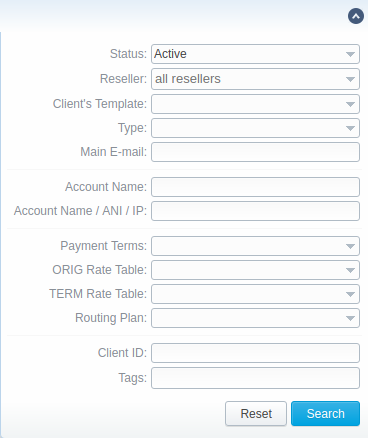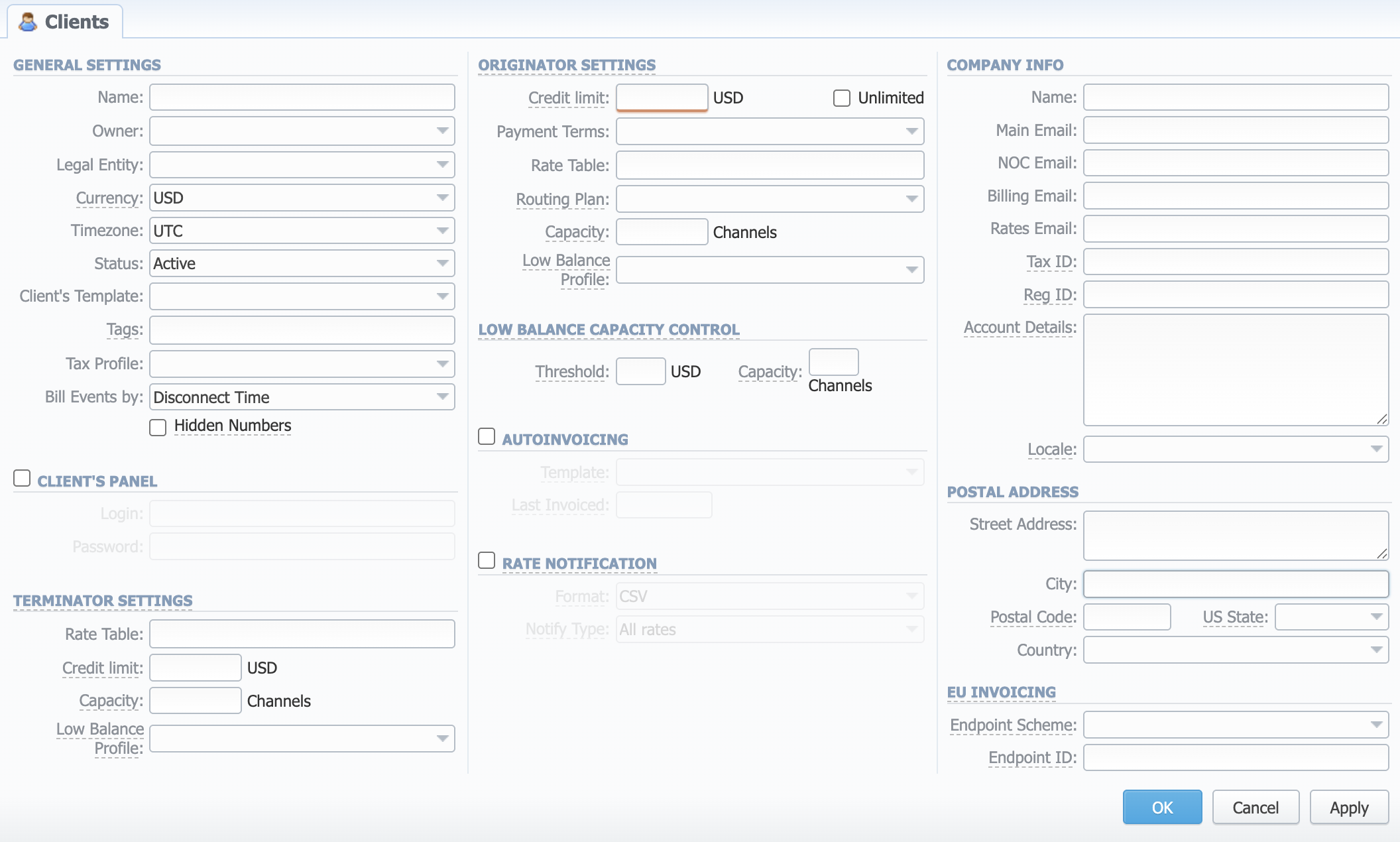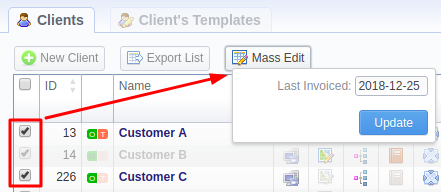Clients
Please do not remove Client entities completely from the system. It may cause distortions and overall mismatches in stored statistics. Instead, set their status to "deleted".
Section overview
Clients are a cornerstone and the most valuable asset of any type of business. Hence, the Clients section is rightfully considered a core element of the whole JeraSoft Billing. In the section, user can manage the personal information of any Client on the list, trace customer's balances, review Resellers a particular client belongs to, etc.

- ID: Client's identification number
- Name: Client's name
- Balance: Client's balance values:
- Available - Live client's balance including allowed credit
- Live - Client's balance calculated on the basis of the performed payments and processed calls
- Fixed - Client's balance calculated on the basis of the outstanding invoices and performed payments
- Pay Terms: Payment terms of each Client
- Tags: List of tags, applied to a Client
- Reseller: Name of reseller's company respective client belongs to
Functional buttons and icons, presented in the section, are as follows:
| Button/Icon | Description |
|---|---|
 | Allows adding a new Client to the system |
 | Allows exporting a list of user's Clients in a .csv file |
 | Allows managing the last invoice date of a Client |
| Identifies the Orig Client | |
| Identifies the Term Client | |
| Identifies the Orig/Term Client | |
 | Allows accessing the list of Client's Accounts in the Accounts section (an icon will be colored if an account is assigned) |
 | Allows accessing the Client's current Routing Plan (an icon will be colored if the plan is assigned) |
 | Allows accessing the Traffic Processing section for Dynamic Routing management |
 | Allows viewing client's Rates (an icon will be colored if a Rate Table is assigned). When clicked, the system will display two Rate Tables options per Client: ORIG: Rate Tables for origination, TERM: Rate Tables for termination. |
 | Allows accessing the Subscriptions section for new clients Packages management |
 | Allows accessing the Transactions section for client's Balance management |
 | Allows accessing the Invoices section for client's invoices management |
 | Allows accessing the Balance Report section for client's balance report (Live or Fixed) management (last 7 days of statistics) |
 | Allows accessing the Summary Report section for client's summary report management (last 7 days of statistics) |
 | Allows accessing the Mail Queue section to view sent emails history |
 | Allows accessing the Audit Log section to view change history |
 | Allows deleting a Client from the system |
When you delete the Client by changing the status to "deleted" or clicking a respective icon, the Client Panel of this Client will be disabled and origination/termination settings of its Accounts will be turned off. However, its Accounts will not be deleted from the system.
- If the prepaid mode is enabled, calls will be subject to balance check on a stage of call authorization (when RADIUS Authorization is used). If the postpaid mode is enabled, calls duration will be limited to Max сall length setting in Configuration → Settings.
- You can search through Clients by name and by first letters only (start with rule). To find all Clients with a specified main email, use * (asterisk) in the *Main Email* field.
Advanced search
In the top right corner of the section above the table, the Advanced Search drop-down menu is located. By clicking on a red downwards arrow icon (Clients in the section are filtered by "Active" status by default), the following drop-down menu is displayed:

To apply the specified search criteria, click the Search button; to cancel the applied parameters, click Reset.
Adding a new Client
To add a new customer in the system, click the New Client button in the top-left corner of the section. A pop-up window with the following fields will show up:

General settings
General information about the Client
-
Name: Indicate a client's name
-
Owner: Select a Reseller (company) this new Client belongs to
-
Legal Entity: Select a Legal Entity, from under which the Invoice would be sent to the new Client
-
Currency: Define preferred currency (will be used in invoices). To keep correct accounting data, it is not allowed to switch the currency of the Client once the accounting transactions are created in the system.
tipOnce you create a Client and the system tracks any Transactions with them, you cannot change the currency in their settings anymore. However, if you have to change the currency for the Client and would like to have new Transactions in that currency, here’s what you can do:
- Archive the existing Client entity (all previous Transactions with them stay intact);
- Add the Client as new and assign the currency in which you would like to receive payments from them.
From this point on, the new Transactions of the Client will be in this new currency.
-
Timezone: Choose the timezone from the drop-down list of all available. This timezone will be used in invoices by default. UTC is a default parameter for a timezone
warningIf this parameter is not indicated, the timezone of the database will be automatically applied to the client's settings of the zone. It could lead to some problems while working with packages, rate tables, or time profiles.
-
Status: Select a respective status for the client:
- "active"
- "stopped"
- "deleted"
-
Client's Template: Here you can apply the required template from the list to a new customer
-
Tags: You can indicate tag(s) here that will be applied to a new customer. The tag doesn't need to be pre-existent in the system. You can provide an unlimited number of tags for each Client.
-
Tax Profile: You can specify a Tax Profile, which will be reflected in invoices. In order to select a Tax Profile in this field, the tax profile should be created first in the section Configuration → Taxes Profiles. Check out the Taxes Profiles article for more information. There can be 3 types of the tax profiles used:
- Customer (you will need to manage the tax values manually)
- SureTax (integration with a third-party tax calculation service)
- Compliance (integration with a third-party tax calculation service)
warningFor proper usage of SureTax and Compliance, the Invoice Number should contain only Latin and numeric characters. Max length is 40 symbols. Dst and Src Numbers should be in the NPANXXNNNN (10 digits) format. More info about these third-party tax calculation services can be found in the article US Taxation.
-
Bill Events by: Select how the system should bill events of a new Client – by setup time, by connect time or by disconnect time (most switch models use disconnect time)
-
Hidden Numbers checkbox: When checked, allows you to hide some part of the Client's destination numbers in invoices, xDRs reports and during export.
tipIf the Client has the Hidden Numbers option enabled and the code appears in the Code Deck from the invoice template, the number, code, and code name become hidden. If the code doesn't appear in the code deck, the last *n characters of the number are hidden. The code deck from the rate table is only used to identify code names.
Client Panel checkbox
Activates/deactivates the login procedure to the client's control panel for this Client. Customer can get access to this control panel by using the following link: http://vcs_address/clients/, after filling in the following fields:
- Login: Client's login
- Password: Client's password
Originator settings
Settings for your customers who send events to your switch. Clients' originator settings are as follows:
- Unlimited checkbox: Here you can set the unlimited credit for a Client if you enable the checkbox. It is disabled by default.
- Credit limit: The additional field next to the Unlimited checkbox. Here you can set the credit limit allowed for a Client. You could fill this field with any of the positive or negative numbers, but no more than 9 digits. If the Unlimited checkbox is marked, this field becomes inactive.
- Payment Terms: Select the payment terms template from the general list of all available ones in the Payment Terms section
- Rate Table: From the list of all rate tables in the Rate Tables section, select an Origination one for this Client
- Routing Plan: Select an appropriate Routing Plan that will be used to route all calls of this customer (but it may be overridden for any of the customer's accounts in the Accounts tab). The full list of routing plans is presented in the Routing Plans section
- Capacity: Indicate the Origination capacity of channels for this Client. For unlimited amount, leave empty
- Low Balance Profile: From the list of all available, select a Low Balance Profile for this Client
Terminator settings
Settings for your vendors whom you send events from your switch. Clients' termination settings are as follows:
- Rate Table: From the list of all Rate Tables, select a Termination one for this Client
- Credit limit: Define the credit limit you have on the vendor's side. It will be applied to vendors during the routing check to remove them from the routing result if the vendor's live balance + credit limit hits the entered threshold.
- Capacity: Define the termination capacity of channels for this client. For unlimited amount, leave empty
- Low Balance Profile: From the list of all available, select a Low Balance Profile for this Client
Low balance capacity control
Here you can set up whether the system should limit capacity or not when the Client's Available Balance is lower than a set threshold
- Threshold: Available balance threshold, below which the special capacity setting will be applied
- Capacity: Origination capacity limit that will be applied when the available balance is below the threshold
Autoinvoicing checkbox
Activates/deactivates the automatic invoice generation feature for the current client. Information block parameters are:
- Template: Select an invoice template for this customer
- Last Invoiced: Specify the last date when the Client was invoiced
Rate Notification checkbox
Here you can enable or disable automatic rates notifications for the current Client
- Format: Select the desirable format of rate notification (.xlsx or .csv)
- Notify Type: Specify a type of notification:
- All rates - full rates list will be sent
- Only changed rates - only changed rates will be sent
- All rates (not repeated codes) - if there are two or more new rates with different effective dates for the same code, several files will be sent, each containing a full list of rates and only one unique rate for this code
- The system will push notification after adding new rates. Please note, if the user changes the Effective Date field of current rates manually, they will also be included in the notification.
- When you force Rate Notification, it does not send all the rates with the Effective Date in the future but only the rates that it will be late to send with the next scheduled notification (according to the Agreement assigned to the Rate Table). If there's no Agreement, the Rate Notification will not be sent.
- We recommend using forced notifications for testing purposes. It doesn't cancel a regular notification nor change the last export date.
Company info
Some additional information about a Client can be entered here:
- Name: Company name
- Main Email: Company email for general inquiries. Use only Latin characters.
- NOC Email: Company email for technical related questions. Use only Latin characters.
- Billing Email: Automatically generated invoices and notifications will be sent to this email address. Use only Latin characters.
- Rates Email: Company email for rates related questions. Use only Latin characters.
- Tax ID: Customer's tax ID
- Reg ID: Customer's registration ID
- Account Details: Reference information about the client's bank account or payment details
- For EU PEPPOL invoices: if you put IBAN here, it will be parsed and set in the XML invoices.
- Locale: The preferred locale that will be sent as a reply to RADIUS Authorization. It is used for IVR platforms to define the language
Postal Address
- Street Address: Physical company address
- City
- Postal Code: Postal or ZIP code
- US State: customer's state (for the US)
EU Invoicing
The following settings are used in generating the XML invoices according to the EU PEPPOL specification:
- Endpoint Scheme: select the option from a dropdown that will define the format of the company electronic address (see full list here)
- Endpoint ID: input the company's unique electronic address
- Buyer Reference: input the reference used for internal routing at recipient
You can use multiple emails per field if necessary. Just separate them with a comma or semicolon.
Autoinvoicing tool sends rates in separate files for each time profile used in a certain Rate Table. Please note, the email address should contain only Latin characters for proper work of email notifications and invoices.
The Full Delete button can be used to remove a client from the system permanently, disregarding any statistics or rate tables data connections. Please use this feature with care – the deleted client cannot be restored by any means
Mass Edit
If there is a need to change the last invoice date (i.e. the day that the client has already been invoiced for) for more than one Client, you can use Mass Edit functionality. Follow the next steps:
- Select target Clients;
- Click the Mass Edit button and specify the date in the Last Invoiced field;
- Click the Update button.

Clients Templates
This section allows you to create a client template, where you can specify the main information about a Client, originator settings, etc. Further, this template can be used to set the billing and tariff parameters for customers, managers, or resellers in several clicks. For more details, check out a related article: Clients Templates.